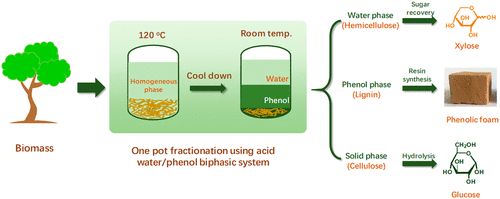当前位置:
X-MOL 学术
›
ACS Sustain. Chem. Eng.
›
论文详情
Our official English website, www.x-mol.net, welcomes your feedback! (Note: you will need to create a separate account there.)
Mild One-Pot Lignocellulose Fractionation Based on Acid-Catalyzed Biphasic Water/Phenol System to Enhance Components’ Processability
ACS Sustainable Chemistry & Engineering ( IF 8.4 ) Pub Date : 2020-01-31 , DOI: 10.1021/acssuschemeng.9b06643 Guanhua Wang 1, 2 , Shuang Qi 1 , Yue Xia 1 , Ashak Mahmud Parvez 3 , Chuanling Si 1 , Yonghao Ni 1, 2
ACS Sustainable Chemistry & Engineering ( IF 8.4 ) Pub Date : 2020-01-31 , DOI: 10.1021/acssuschemeng.9b06643 Guanhua Wang 1, 2 , Shuang Qi 1 , Yue Xia 1 , Ashak Mahmud Parvez 3 , Chuanling Si 1 , Yonghao Ni 1, 2
Affiliation

|
Effective fractionation and utilization of the three main components (cellulose, hemicellulose, and lignin) in lignocellulosic biomass give a significant opportunity for commercial operation of a lignocellulosic biorefinery. Herein, we proposed a one-pot method for lignocellulosic biomass (poplar) fractionation by acidic water/phenol pretreatment at mild temperature (120 °C). By this approach, three phases were obtained: water phase containing hemicellulose-derived sugars, phenol phase containing lignin, and cellulose-enriched solid phase. Up to 90% of original lignin was removed with over 96% original cellulose retained in the solid under the optimized conditions (3.5% acid based on biomass weight, 40% phenol content in water/phenol system, 120 °C, and 1 h). Additionally, 77% of original xylan was recovered from the water phase in the form of xylose, while negligible amounts of byproducts (e.g., furfural) formed due to the mild conditions. The pretreated substrate was enzymatically hydrolyzed to glucose, whose digestibility was 2–3 times higher than those obtained using ethanol and dioxane. The lignin, together with the phenol solvent without further separation, was used to prepare lignin-based phenolic foam with satisfactory mechanical and thermal insulation properties. The work highlights a mild one-pot acid-catalyzed pretreatment strategy to separate three main components of lignocellulose, with enhanced processability, so that value-added products can be made, thus providing an effective route for a lignocellulosic biorefinery.
中文翻译:

基于酸催化双相水/苯酚系统的轻质一锅木质纤维素分级分离,可提高组件的可加工性
木质纤维素生物质中三种主要成分(纤维素,半纤维素和木质素)的有效分馏和利用为木质纤维素生物精炼厂的商业运营提供了重要机会。在本文中,我们提出了在酸性温度/ 120°C下通过酸性水/苯酚预处理对木质纤维素生物质(白杨)进行分馏的一锅法。通过这种方法,获得了三个相:包含半纤维素衍生的糖的水相,包含木质素的酚相和富含纤维素的固相。在优化的条件下(固体含量为3.5%的酸,40%的水/苯酚体系中的苯酚含量,120°C和1 h),最多可去除90%的原始木质素,并保留超过96%的原始纤维素。 。另外,从木糖形式的水相中回收了77%的原始木聚糖,而由于条件温和,形成的副产物(例如糠醛)量可忽略不计。预处理的底物被酶水解为葡萄糖,其消化率比使用乙醇和二恶烷获得的消化率高2–3倍。木质素与苯酚溶剂无需进一步分离即可用于制备具有令人满意的机械和隔热性能的木质素基酚醛泡沫。这项工作突出了温和的一锅法酸催化预处理策略,以分离木质纤维素的三个主要成分,并提高了可加工性,从而可以制造增值产品,从而为木质纤维素生物炼制提供了一条有效途径。糠醛)由于温和的条件而形成。预处理的底物被酶水解为葡萄糖,其消化率比使用乙醇和二恶烷获得的消化率高2–3倍。木质素与苯酚溶剂无需进一步分离即可用于制备具有令人满意的机械和隔热性能的木质素基酚醛泡沫。这项工作突出了温和的一锅法酸催化预处理策略,以分离木质纤维素的三个主要成分,并提高了可加工性,从而可以制造增值产品,从而为木质纤维素生物炼制提供了一条有效途径。糠醛)由于温和的条件而形成。预处理的底物被酶水解为葡萄糖,其消化率比使用乙醇和二恶烷获得的消化率高2–3倍。木质素与苯酚溶剂无需进一步分离即可用于制备具有令人满意的机械和隔热性能的木质素基酚醛泡沫。这项工作突出了温和的一锅法酸催化预处理策略,以分离木质纤维素的三个主要成分,并提高了可加工性,从而可以制造增值产品,从而为木质纤维素生物炼制提供了一条有效途径。与酚溶剂一起使用,无需进一步分离,就可以制备具有令人满意的机械和隔热性能的木质素基酚醛泡沫。这项工作突出了温和的一锅法酸催化预处理策略,以分离木质纤维素的三个主要成分,并提高了可加工性,从而可以制造增值产品,从而为木质纤维素生物炼制提供了一条有效途径。与酚溶剂一起使用,无需进一步分离,就可以制备具有令人满意的机械和隔热性能的木质素基酚醛泡沫。这项工作突出了温和的一锅法酸催化预处理策略,以分离木质纤维素的三个主要成分,并提高了可加工性,从而可以制造增值产品,从而为木质纤维素生物炼制提供了一条有效途径。
更新日期:2020-02-03
中文翻译:

基于酸催化双相水/苯酚系统的轻质一锅木质纤维素分级分离,可提高组件的可加工性
木质纤维素生物质中三种主要成分(纤维素,半纤维素和木质素)的有效分馏和利用为木质纤维素生物精炼厂的商业运营提供了重要机会。在本文中,我们提出了在酸性温度/ 120°C下通过酸性水/苯酚预处理对木质纤维素生物质(白杨)进行分馏的一锅法。通过这种方法,获得了三个相:包含半纤维素衍生的糖的水相,包含木质素的酚相和富含纤维素的固相。在优化的条件下(固体含量为3.5%的酸,40%的水/苯酚体系中的苯酚含量,120°C和1 h),最多可去除90%的原始木质素,并保留超过96%的原始纤维素。 。另外,从木糖形式的水相中回收了77%的原始木聚糖,而由于条件温和,形成的副产物(例如糠醛)量可忽略不计。预处理的底物被酶水解为葡萄糖,其消化率比使用乙醇和二恶烷获得的消化率高2–3倍。木质素与苯酚溶剂无需进一步分离即可用于制备具有令人满意的机械和隔热性能的木质素基酚醛泡沫。这项工作突出了温和的一锅法酸催化预处理策略,以分离木质纤维素的三个主要成分,并提高了可加工性,从而可以制造增值产品,从而为木质纤维素生物炼制提供了一条有效途径。糠醛)由于温和的条件而形成。预处理的底物被酶水解为葡萄糖,其消化率比使用乙醇和二恶烷获得的消化率高2–3倍。木质素与苯酚溶剂无需进一步分离即可用于制备具有令人满意的机械和隔热性能的木质素基酚醛泡沫。这项工作突出了温和的一锅法酸催化预处理策略,以分离木质纤维素的三个主要成分,并提高了可加工性,从而可以制造增值产品,从而为木质纤维素生物炼制提供了一条有效途径。糠醛)由于温和的条件而形成。预处理的底物被酶水解为葡萄糖,其消化率比使用乙醇和二恶烷获得的消化率高2–3倍。木质素与苯酚溶剂无需进一步分离即可用于制备具有令人满意的机械和隔热性能的木质素基酚醛泡沫。这项工作突出了温和的一锅法酸催化预处理策略,以分离木质纤维素的三个主要成分,并提高了可加工性,从而可以制造增值产品,从而为木质纤维素生物炼制提供了一条有效途径。与酚溶剂一起使用,无需进一步分离,就可以制备具有令人满意的机械和隔热性能的木质素基酚醛泡沫。这项工作突出了温和的一锅法酸催化预处理策略,以分离木质纤维素的三个主要成分,并提高了可加工性,从而可以制造增值产品,从而为木质纤维素生物炼制提供了一条有效途径。与酚溶剂一起使用,无需进一步分离,就可以制备具有令人满意的机械和隔热性能的木质素基酚醛泡沫。这项工作突出了温和的一锅法酸催化预处理策略,以分离木质纤维素的三个主要成分,并提高了可加工性,从而可以制造增值产品,从而为木质纤维素生物炼制提供了一条有效途径。


























 京公网安备 11010802027423号
京公网安备 11010802027423号